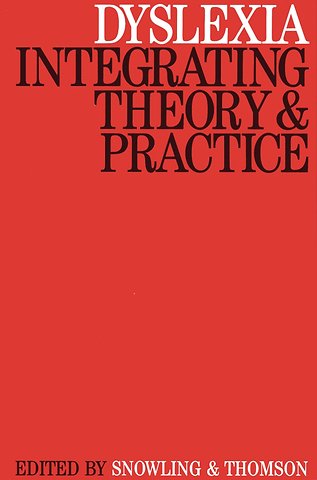Dyslexia – Integrating Theory and Practice
Integrating Theory & Practice
Samenvatting
This work brings together the papers to be presented at the Second International Conference of the British Dyslexia Association. This conference is intended to examine a variety of aspects of dyslexia, within the following general themes – education, language, biological bases, cognition, development of literacy and numeracy and and social and behavioural elements. The contreibutors are specialists in their fields.
Specificaties
Inhoudsopgave
<p>Acknowledgements.</p>
<p>Editorial.</p>
<p>Part 1: Biological bases.</p>
<p>Chapter 1 Genetics and Dyslexia: an overview – John C.DeFries.</p>
<p>Chapter 2 Neurobiological issues in dyslexia – Drake D. Duane.</p>
<p>Chapter 3 Vision and language – John F. Stein.</p>
<p>Chapter 4 EEG topographical mapping and laterality measures in dyslexic children – Georgina Rippon.</p>
<p>Part II: The normal development of literacy.</p>
<p>Chapter 5 The development of reading and spelling in children: an overview – Linnea Ehri.</p>
<p>Chapter 6 Spelling and sound in learning to read – Nick Ellis.</p>
<p>Chapter 7 Metaphonological abilities and literacy – Jose Morais.</p>
<p>Chapter 8Recent work on reading and spelling development – Usha Goswami.</p>
<p>Part III: The definition, nature and prevalence of dyslexia.</p>
<p>Chapter 9 The theoretical and practical consquences of discrepancy definitions of dyslexia – Keith E. Stanovich.</p>
<p>Chapter 10 On determining the prevalence of dyslexia – Tim R. Miles.</p>
<p>Chapter 11 Phonological and visual segmentation problems in poor readers – Rhona Brown and Frances Watson.</p>
<p>Part IV: Intervention: theoretical and practical issues.</p>
<p>Chapter 13 Dyslexia: the obvious and hidden speech and language disorder – Joy Stackhouse and Bill Wells.</p>
<p>Chapter 14 Visual dyslexia/auditory dyslexia: is this a valuable distinction? – Elaine Miles.</p>
<p>Chapter 15 Is medicinal treatment of dyslexia advisable – Colin Wilsher.</p>
<p>Part V: Intervention: empirical studies of teaching.</p>
<p>Chapter 16 The remediation of reading comprehension difficulties.</p>
<p>Chapter 17 The beneficial effect of accelerating reading rate: on dyslexic readers′ reading comprehension – Zvia Breznitz.</p>
<p>Chapter 18 The teaching of spelling using techniques of simultaneous oral spelling and visual inspection – Michael Thomson.</p>
<p>Part VI: Intervention: the practical skills of dyslexic teaching.</p>
<p>Chapter 19 Factors to consider when designing a test protocol in mathematics for dyslexics – Steve J Chinn.</p>
<p>Chapter 20 Mathematics and dyslexics – after basics what then? – Anne Henderson.</p>
<p>Chapter 21 Communication and study skills at primary level – Patience Thomson.</p>
<p>Chapter 22 Curriculum–based study skills – Virginia Kelly.</p>
<p>Chapter 23 The road to reading: basic skills to college allowances – Arlene W. Sonday.</p>
<p>Chapter 24 Setting up a learning programme for adult dyslexics – Cynthia Klein.</p>
<p>Chapter 25 The dyslexic child′s transfer of learning from the individual less to work in the classroom – Ann Cooke.</p>
<p>Chapter 26 The use of tape–recorders to develop speaking and listening skills – Jeanne Reilly.</p>
<p>Chapter 27 Pupil′s self–evaluation as an aid to teaching handwriting – Jane Taylor.</p>
<p>Chapter 28 A multisensory approach towards reading music – Margaret Hubicki.</p>
<p>Index.</p>
Anderen die dit kochten, kochten ook
Net verschenen
Rubrieken
- aanbestedingsrecht
- aansprakelijkheids- en verzekeringsrecht
- accountancy
- algemeen juridisch
- arbeidsrecht
- bank- en effectenrecht
- bestuursrecht
- bouwrecht
- burgerlijk recht en procesrecht
- europees-internationaal recht
- fiscaal recht
- gezondheidsrecht
- insolventierecht
- intellectuele eigendom en ict-recht
- management
- mens en maatschappij
- milieu- en omgevingsrecht
- notarieel recht
- ondernemingsrecht
- pensioenrecht
- personen- en familierecht
- sociale zekerheidsrecht
- staatsrecht
- strafrecht en criminologie
- vastgoed- en huurrecht
- vreemdelingenrecht






